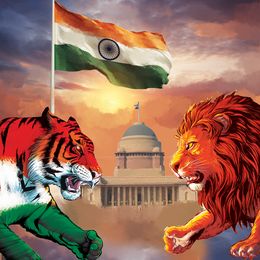Ever since the British left us to our fate, freedom and franchise, many Indians have yearned for a two-party system like the way they have it in England—a neat polity where two parties contest for power, and the loser would shadow the ruler. They forget that we got our freedom when a third party came to power on its own in the UK.
A few of us are also fascinated by the American way, where two parties fight for the top job in a neatly choreographed election where everything, except the winner, is pre-determined—the term of office, the date of polling, the date of counting, the date of inauguration, everything. The Ram Nath Kovind committee has prescribed something of that kind for us, boring to the core, but in a multi-party order.
Yearning for a two-party polity is one thing, but getting it is another. It ought to evolve. We can’t will it into being or wish it into existence. Why should we? Ours is a multi-culture society where our myriad political wills and electoral wishes can’t be force-packed into a bland political binary.
Yet, like it or not, we seem to be evolving into a two-front polity. West Bengal and Kerala had in effect been two-front polities since nearly half a century, though the warriors on the fronts have changed. Rajasthan, Gujarat, Madhya Pradesh, Chhattisgarh, Himachal Pradesh and Uttarakhand have become two-party polities; Maharashtra has become a two-front polity.
At the federal level, we have been evolving into a two-front polity since the collapse of the Janata experiments of the late 1990s. This election has catalysed the process. Narendra Modi’s NDA has remained more or less solid for the last several years; now the opposition, which fought as disparate elements in the last two rounds, has consolidated over the last few months. There still are sulking truants like Mamata Banerjee, but it looks like the contours of both the alliances have more or less consolidated.
Would the fronts hold fast after the polls, especially if neither front makes it to the halfway mark, as many are predicting? The answer is difficult. It would all depend on who gathers more of the fortune-hunting freebooters, and who can lure more quislings from the other side.
The early bird will get the worms. The Congress learnt it the hard way in Goa and Manipur in 2017, and in Meghalaya in 2018. By the time the final count was out, the BJP, which won fewer seats, had more MLAs to take to the governor. The story could be the same in Delhi this time, if neither front is sure of a clear win. The game could already be afoot. Who makes the next government will be decided after the last vote is cast on June 1, and the first vote is counted on June 4.
Indeed, moves made in such interregnums can go wrong. Political lore has it that, though fighting each other in Karnataka, H.D. Deve Gowda had assured P.V. Narasimha Rao of the support of his Janata Dal in case Rao fell short of MPs in 1996. But how the table turned! After the polls, Rao was forced to lend his many Congress MPs as outside supporters to Gowda’s few MPs who sat on the treasury benches. That was when Pramod Mahajan made the famous joke about how he had to tell his Chinese hosts about the largest party sitting in the opposition, the second largest party sitting outside the government, and the smallest of the three in the government.
That miracle was made possible by a crafty communist, one who spurned kingship for himself or any of his partymen, but loved making others kings. His name: Harkishan Singh Surjeet.
Does India or INDIA have one like him now?
prasannan@theweek.in


